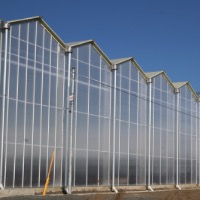Measurement of longwave radiative properties of energy-saving greenhouse screens

Published: 30 September 2021
Abstract Views: 1066
PDF: 505
HTML: 12
HTML: 12
Publisher's note
All claims expressed in this article are solely those of the authors and do not necessarily represent those of their affiliated organizations, or those of the publisher, the editors and the reviewers. Any product that may be evaluated in this article or claim that may be made by its manufacturer is not guaranteed or endorsed by the publisher.
All claims expressed in this article are solely those of the authors and do not necessarily represent those of their affiliated organizations, or those of the publisher, the editors and the reviewers. Any product that may be evaluated in this article or claim that may be made by its manufacturer is not guaranteed or endorsed by the publisher.
Similar Articles
- Enrica Santolini, Alberto Barbaresi, Daniele Torreggiani, Patrizia Tassinari, Numerical simulations for the optimisation of ventilation system designed for wine cellars , Journal of Agricultural Engineering: Vol. 50 No. 4 (2019)
- Kishor P. Kolhe, Demelash G. Lemi, Siraj K. Busse, Studies of tractor maintenance and replacement strategies of Wonji Shoa Factory, Ethiopia , Journal of Agricultural Engineering: Vol. 55 No. 1 (2024)
- Alessandro Biglia, Francesco Gresta, Davide Lucien Patono, Lorenzo Comba, Claudio Lovisolo, Paolo Gay, Andrea Schubert, Identification of drought-salinity combined stress in tomato plants by vegetation indices , Journal of Agricultural Engineering: Early Access
- Antonino Capra, Simona Consoli, Baldassare Scicolone, WATER MANAGEMENT STRATEGIES UNDER DEFICIT IRRIGATION , Journal of Agricultural Engineering: Vol. 39 No. 4 (2008)
- José Roberto Moreira Ribeiro Gonçalves, Gabriel Araújo e Silva Ferraz, Étore Francisco Reynaldo, Diego Bedin Marin, Patrícia Ferreira Ponciano Ferraz, Manuel Pérez-Ruiz, Giuseppe Rossi, Marco Vieri, Daniele Sarri, Comparative analysis of soil-sampling methods used in precision agriculture , Journal of Agricultural Engineering: Vol. 52 No. 1 (2021)
- Dario Friso, Lucia Bortolini, Influence of the trajectory angle and nozzle height from the ground on water distribution radial curve of a sprinkler , Journal of Agricultural Engineering: Vol. 43 No. 1 (2012)
- Alina Evelyn Badillo-Márquez, Jonathan J. Cid-Galiot, Rubén Posada-Gómez, Alberto Alfonso Aguilar-Lasserre, Automated system for the detection of risk in agricultural sugarcane harvesting using digital image processing and deep learning , Journal of Agricultural Engineering: Vol. 55 No. 3 (2024)
- Daniele Masseroni, Jasim Uddin, Reece Tyrrell, Iven Mareels, Claudio Gandolfi, Arianna Facchi, Towards a smart automated surface irrigation management in rice-growing areas in Italy , Journal of Agricultural Engineering: Vol. 48 No. 1 (2017)
- Surachai Hemhirun, Pracha Bunyawanichakul, Effect of the initial moisture content of the paddy drying operation for the small community , Journal of Agricultural Engineering: Vol. 51 No. 3 (2020)
- Simona M.C. Porto, Giulia Castagnolo, Francesca Valenti, Giovanni Cascone, Kernel density estimation analyses based on a low power-global positioning system for monitoring environmental issues of grazing cattle , Journal of Agricultural Engineering: Vol. 53 No. 2 (2022)
<< < 18 19 20 21 22 23 24 25 26 27 > >>
You may also start an advanced similarity search for this article.

 https://doi.org/10.4081/jae.2021.1209
https://doi.org/10.4081/jae.2021.1209







